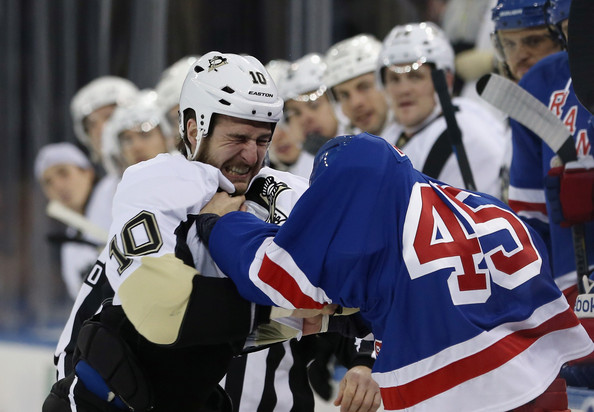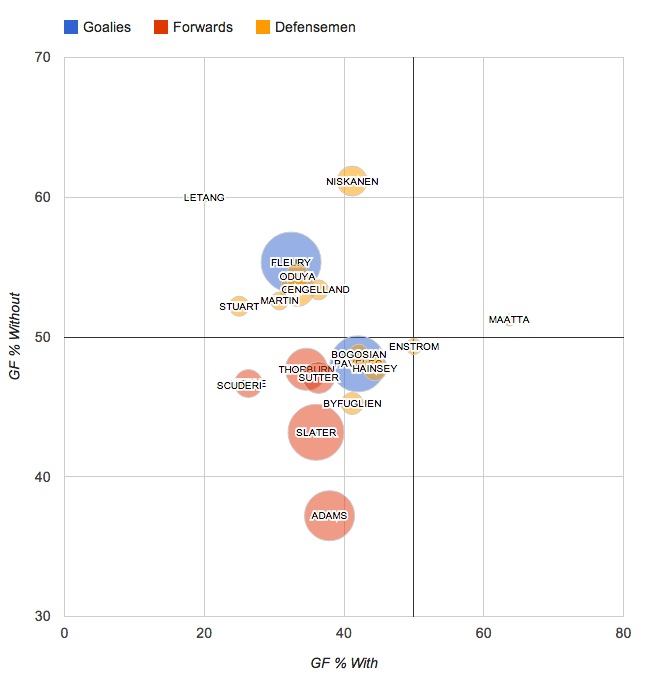If you’ve been coming here for a while, then you know we very rarely call out management decisions. It’s not our style. We question, we find positives, we find reasons, and while we may not agree with a transaction, we discuss and move on. This is one of those rare occurrences where I tried, but could not. But don’t take that the wrong way, there’s still plenty of discussion to be had over Tanner Glass.
Look, I understand why Alain Vigneault wanted him. I understand why Glen Sather wanted him. He’s a good skater, he’s fairly fast, he’s familiar with AV’s style, he kills penalties, and he wins fights (which doesn’t really mean anything in relation to wins). The Rangers had a big, big hole on the fourth line when they lost both Brian Boyle and Derek Dorsett, and they wanted Glass for the aforementioned reasons. I get it.
But as we did with Lee Stempniak (a signing we love here), it’s time to take a look into the deeper numbers for Glass.
Looking at his WOWYs (with or without you) from last year, which depicts his influence on his teammates’ puck possession numbers while on and off the ice, Glass was an absolute tire fire (graphs courtesy of Hockey Analysis):
Reminder, you want to have your teammates in the lower right corner, or at least on the right half of the chart. A circle on the lower right corner means Glass drove puck possession with that player while on the ice, but the player struggled without him. A circle on the right side of the graph means that Glass at least drove puck possession. Notice the big white area on the right side of the chart? That means Glass was a net negative while on the ice with every single teammate. Even worse is that a good portion of his teammates actually faired better without Glass (top half of the chart). He was the worst player in the league in driving puck possession, relative to his team/teammates.
I know what your argument is going to be: Corsi doesn’t measure “heart, grit, puck battles, and corner battles.” You are correct that Corsi doesn’t measure the first two. But riddle me this: If you win a puck battle or a corner battle, and you come away with the puck, doesn’t that mean you have puck possession?
Puck possession isn’t your thing? Let’s look at goals, with Glass again aiming to be on the lower right corner of the chart:
The same problem exists here as well. So, the team isn’t scoring while he’s on the ice either.
One-year samples not enough? Let’s look at his three-year samples. Every single player had better numbers away from Glass. Same goes for his five-year samples.
I know your next argument: Glass isn’t here to score goals, he’s here to prevent them. Well, we have a stat for that too. This one measure the percentage of goals scored versus goals allowed while on the ice. It’s called GF%. Above 50% is good, below 50% is bad. Glass had a 35.8% goals-for ratio (20th-worst in the league), which was -16.5% in relative terms (10th-worst in the league).
Corsi doesn’t measure everything, and no one ever said it does. Glass does offer some positives to a team looking to fill holes after being decimated in free agency. But the numbers here don’t lie, Glass is a massive anchor on the fourth line, and he’s attempting to fill a hole on a fourth line that was one of the best in the league last season.
I hope I’m wrong.
Share:
More About:Players



